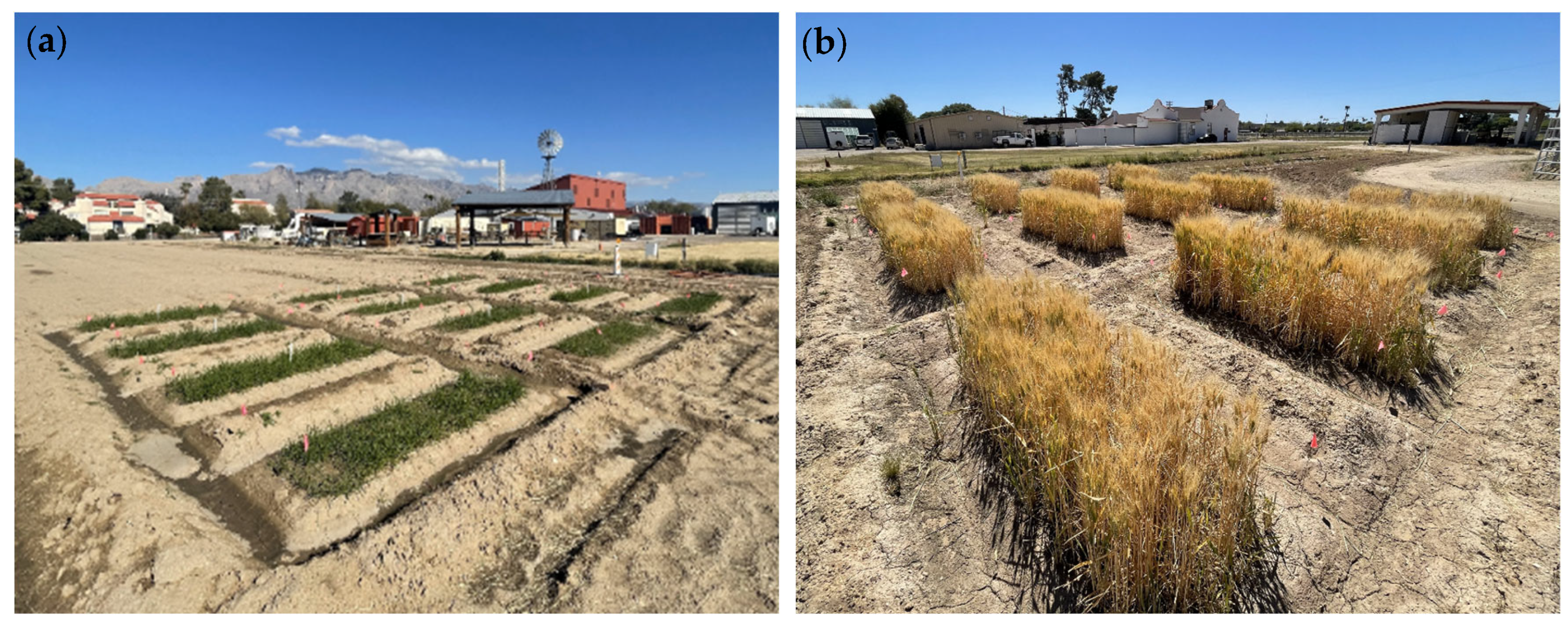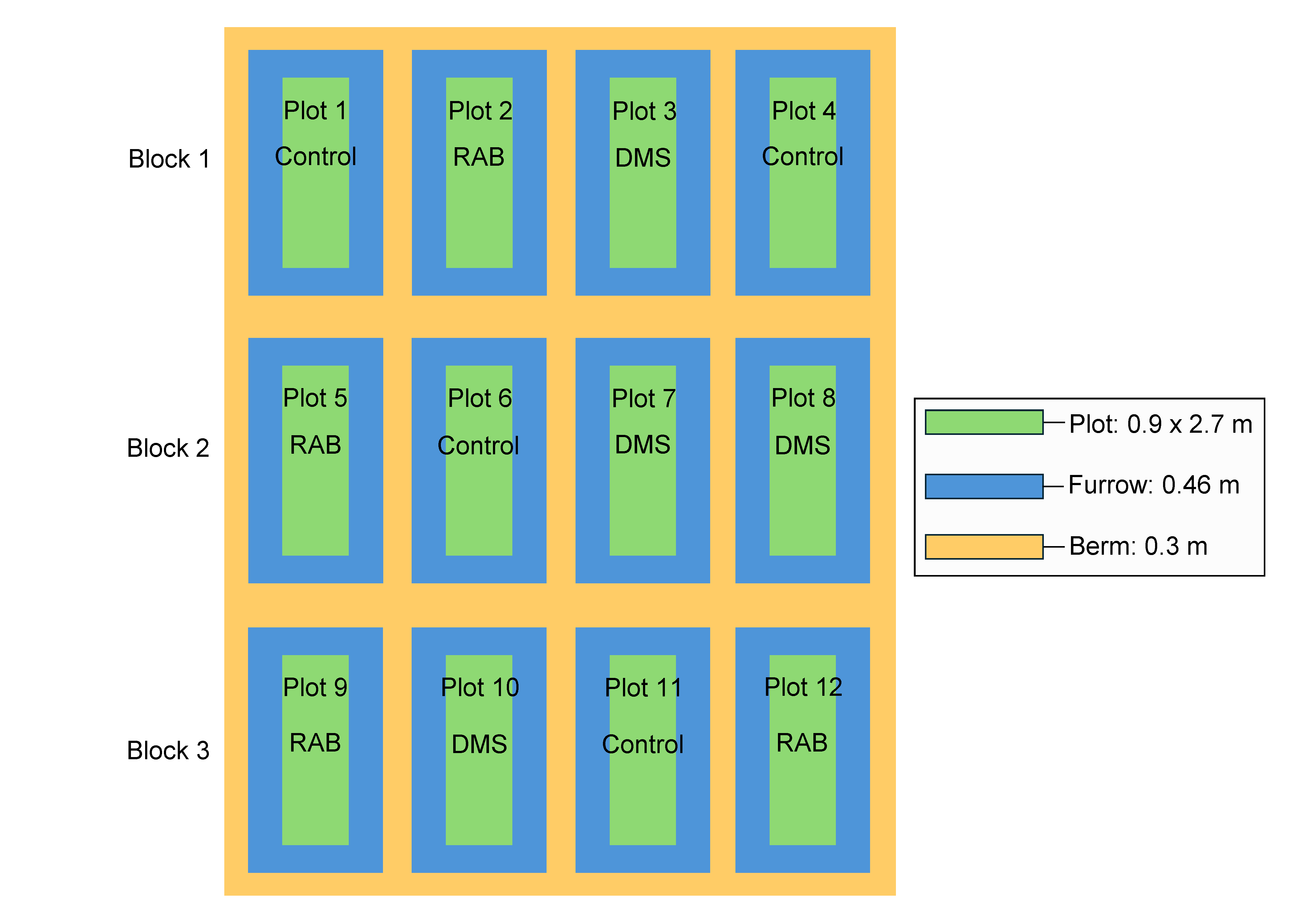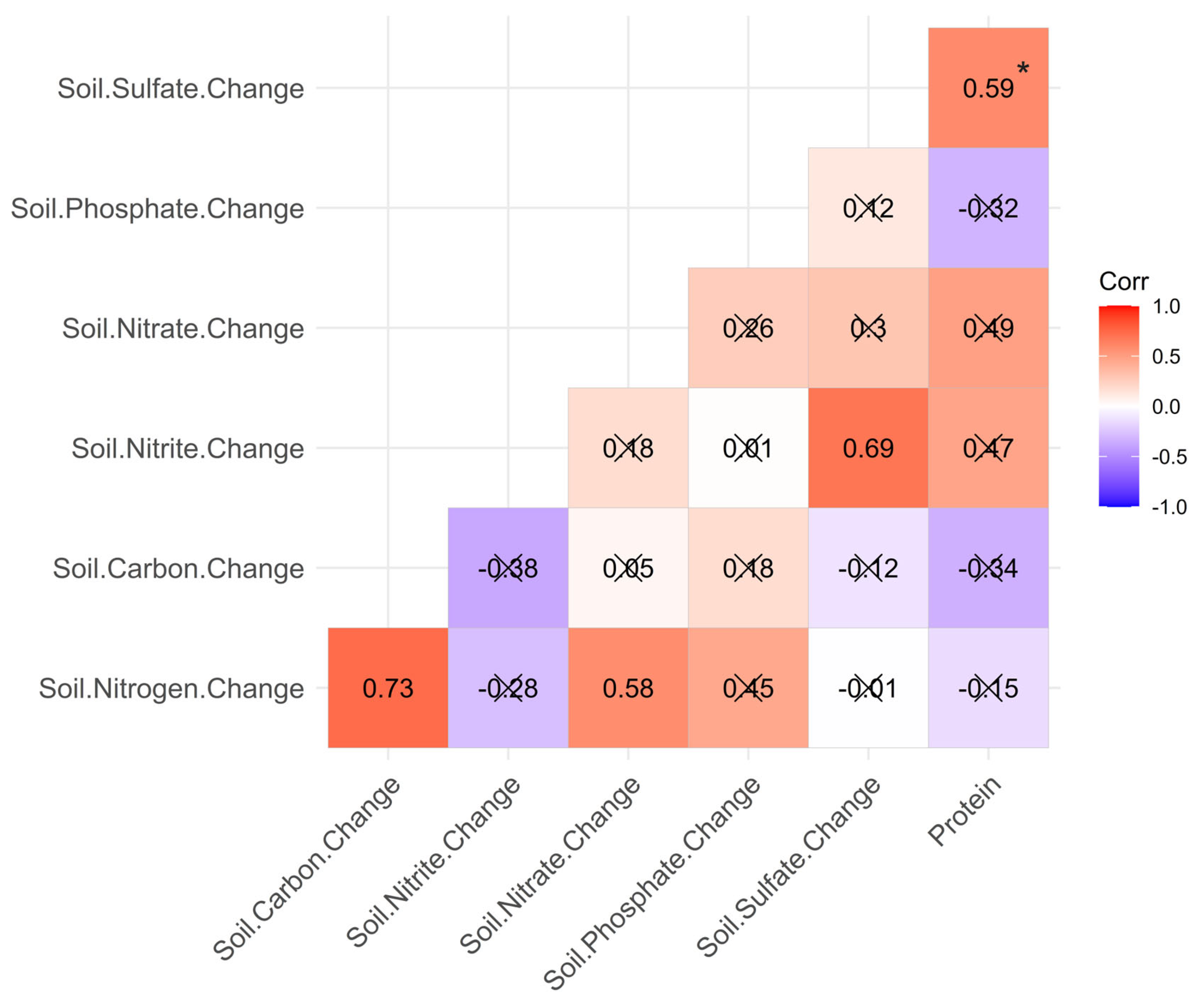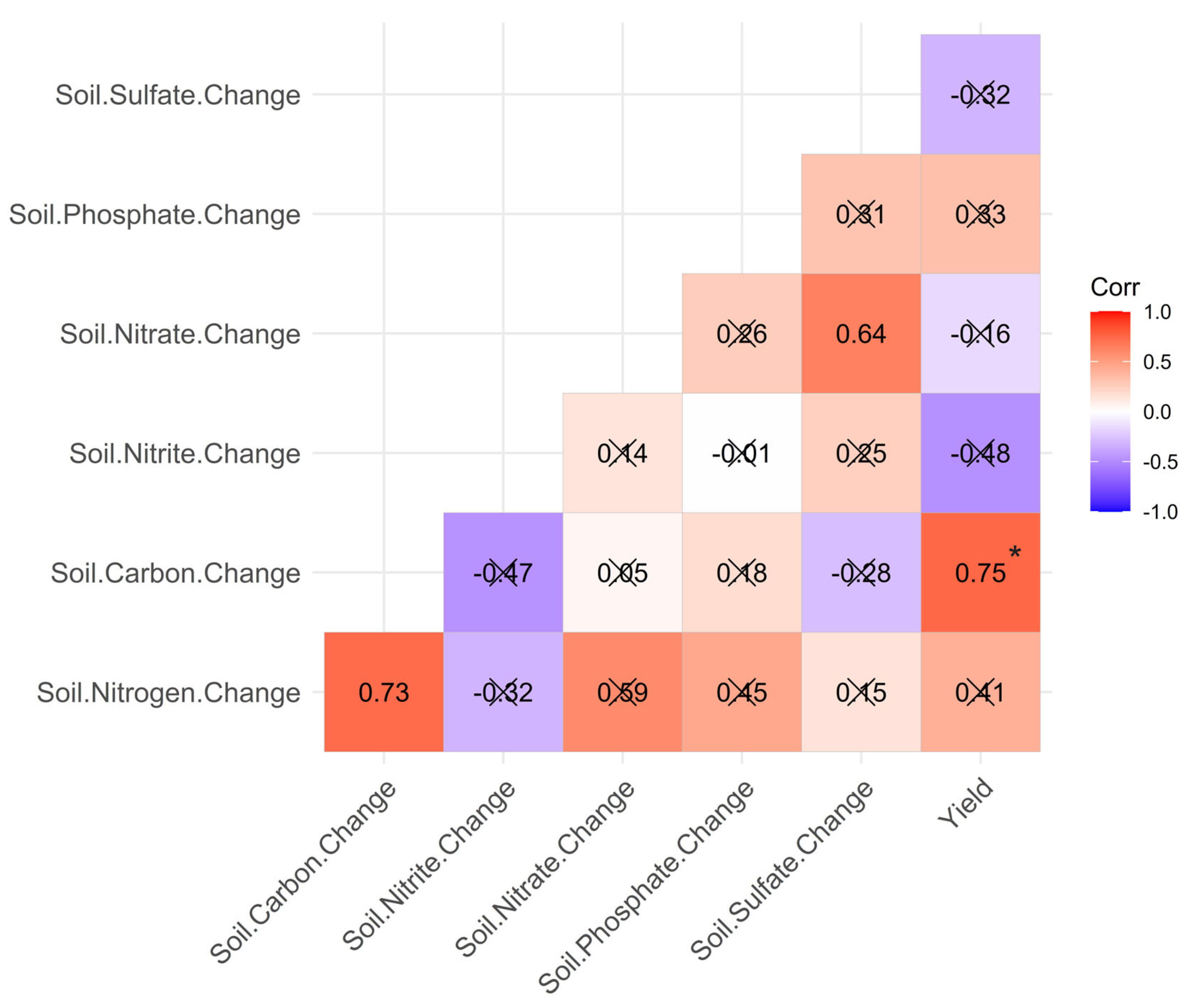Recirculating Aquaculture Biosolids Are Comparable to Synthetic Fertilizers for Grain Protein and Yield in Durum Wheat
Abstract
1. Introduction
2. Materials and Methods
2.1. Site Description and Experimental Design
2.2. Fertilizer Treatments
2.3. Seeding and Emergence
2.4. Soil Sampling and Laboratory Analysis
2.5. Grain Harvest and Analysis
2.6. Statistical Analysis
2.7. Environmental and Replicability Considerations
2.8. Ethical Considerations
3. Results
3.1. Fertilizer Composition
| Fertilizer | Total Carbon (g kg−1) | Total Nitrogen (g kg−1) | Total Sulfur (g kg−1) |
|---|---|---|---|
| MAP | NA | 110 | BDL |
| UAN | NA | 320 | BDL |
| DMS | 207 | 35 | 5 |
| RAB | 331 | 44 | 19 |
| Fertilizer | Nitrite (µmol L−1) | Nitrate (µmol L−1) | Phosphate (µmol L−1) | Sulfate (µmol L−1) |
|---|---|---|---|---|
| MAP | NA | NA | 8694 1 | NA |
| UAN | NA | 5710 1 | NA | NA |
| DMS | 388 | BDL | 2458 | 5856 |
| RAB | 430 | 48 | 328 | 15,640 |
3.2. Soil Composition
3.3. Wheat Quality Metrics
3.4. Statistical Analyses
3.4.1. Grain Protein Content
3.4.2. Grain Yield
3.4.3. Soil Nutrient Concentrations
3.4.4. Regression Analyses
3.4.5. Correlation Analyses
4. Discussion
4.1. Interpretation of Fertilizer Composition Results
4.1.1. Fertilizer Carbon, Nitrogen, and Sulfur Composition
4.1.2. Fertilizer Anion Concentrations
4.1.3. Implications for Fertilizer Selection
4.2. Interpretation of Soil Composition Results
4.2.1. Soil Carbon, Nitrogen, and Sulfur Composition
4.2.2. Soil Anion Concentrations
4.2.3. Fertilizer Impacts on Soil Health and Sustainable Integration
4.3. Interpretation of Wheat Quality Metrics
4.3.1. Grain Protein Content in Context
4.3.2. Grain Yield in Context
4.4. Interpretation of Regression Analyses
4.5. Interpretation of Correlation Analyses
5. Conclusions
Supplementary Materials
Author Contributions
Funding
Data Availability Statement
Acknowledgments
Conflicts of Interest
Abbreviations
| RAB | recirculating aquaculture system biosolids |
| DMS | dairy manure solids |
| MAP | monoammonium phosphate |
| UAN | urea-ammonium nitrate |
| RAS | recirculating aquaculture system |
| ANOVA | analysis of variance |
| HSD | honestly significant difference (Tukey’s post hoc test) |
References
- Smil, V. Enriching the Earth: Fritz Haber, Carl Bosch, and the Transformation of World Food Production; MIT Press: Cambridge, MA, USA, 2004. [Google Scholar]
- Tilman, D.; Cassman, K.G.; Matson, P.A.; Naylor, R.; Polasky, S. Agricultural sustainability and intensive production practices. Nature 2002, 418, 671–677. [Google Scholar] [CrossRef]
- Smith, P.; Bustamante, M.; Ahammad, H.; Clark, H.; Dong, H.; Elsiddig, E.; Haberl, H.; Harper, R.; House, J.; Jafari, M.; et al. Agriculture, forestry and other land use (AFOLU). In Climate Change 2014: Mitigation of Climate Change. Contribution of Working Group III to the Fifth Assessment Report of the Intergovernmental Panel on Climate Change; Cambridge University Press: Cambridge, UK, 2014. [Google Scholar]
- Wyer, K.E.; Kelleghan, D.B.; Blanes-Vidal, V.; Schauberger, G.; Curran, T.P. Ammonia emissions from agriculture and their contribution to fine particulate matter: A review of implications for human health. J. Environ. Manag. 2022, 323, 116285. [Google Scholar] [CrossRef]
- Lal, R. Restoring soil quality to mitigate soil degradation. Sustainability 2015, 7, 5875–5895. [Google Scholar] [CrossRef]
- Mekonnen, M.M.; Hoekstra, A.Y. Four billion people facing severe water scarcity. Sci. Adv. 2016, 2, e1500323. [Google Scholar] [CrossRef] [PubMed]
- Carpenter, S.R.; Caraco, N.F.; Correll, D.L.; Howarth, R.W.; Sharpley, A.N.; Smith, V.H. Nonpoint pollution of surface waters with phosphorus and nitrogen. Ecol. Appl. 1998, 8, 559–568. [Google Scholar] [CrossRef]
- Nicholson, F.A.; Smith, S.R.; Alloway, B.J.; Carlton-Smith, C.; Chambers, B.J. An inventory of heavy metals inputs to agricultural soils in England and Wales. Sci. Total Environ. 2003, 311, 205–219. [Google Scholar] [CrossRef]
- Li, Y.; McCrory, D.F.; Powell, J.M.; Saam, H.; Jackson-Smith, D. A survey of selected heavy metal concentrations in Wisconsin dairy feeds. J. Dairy Sci. 2005, 88, 2911–2922. [Google Scholar] [CrossRef]
- Arikan, O.A.; Mulbry, W.; Rice, C. Management of antibiotic residues from agricultural sources: Use of composting to reduce chlortetracycline residues in beef manure from treated animals. J. Hazard. Mater. 2009, 164, 483–489. [Google Scholar] [CrossRef]
- Kaur, J. Pharmaceuticals as emerging contaminant in agriculture: Source, transport, ecological risks, and removal strategies. In Sustainable Agriculture Reviews; Springer: Cham, Switzerland, 2021; pp. 133–176. [Google Scholar] [CrossRef]
- Goss, M.J.; Unc, A.; Chen, S. Transport of nitrogen, phosphorus and microorganisms from manure into surface- and groundwater. In Biological Resource Management Connecting Science and Policy; Springer: Berlin/Heidelberg, Germany, 2000; pp. 31–55. [Google Scholar]
- FAO. The State of World Fisheries and Aquaculture 2024: Blue Transformation in Action; Food and Agriculture Organization of the United Nations: Rome, Italy, 2024. [Google Scholar]
- Soto, D.; Aguilar-Manjarrez, J.; Hishamunda, N. Building an Ecosystem Approach to Aquaculture; Food and Agriculture Organization of the United Nations: Rome, Italy, 2008. [Google Scholar]
- Boyd, C.E.; Tucker, C.S. Pond Aquaculture Water Quality Management; Springer: New York, NY, USA, 2012. [Google Scholar]
- Naylor, R.L.; Hardy, R.W.; Buschmann, A.H.; Bush, S.R.; Cao, L.; Klinger, D.H.; Little, D.C.; Lubchenco, J.; Shumway, S.E.; Troell, M. A 20-year retrospective review of global aquaculture. Nature 2021, 591, 551–563. [Google Scholar] [CrossRef]
- Cabello, F.C. Heavy use of prophylactic antibiotics in aquaculture: A growing problem for human and animal health and for the environment. Environ. Microbiol. 2006, 8, 1137–1144. [Google Scholar] [CrossRef]
- Schar, D.; Zhao, C.; Wang, Y.; Larsson, D.G.J.; Gilbert, M.; Van Boeckel, T.P. Twenty-year trends in antimicrobial resistance from aquaculture and fisheries in Asia. Nat. Commun. 2021, 12, 5384. [Google Scholar] [CrossRef] [PubMed]
- Timmons, M.B.; Vinci, B.J. The Yellow Book of Recirculating Aquaculture, 5th ed.; Ithaca Publishing Company LLC: Ithaca, NY, USA, 2022. [Google Scholar]
- de Amorim Júnior, S.S.; de Souza Pereira, M.A.; Morishigue, M.; de Costa, R.B.; de Oliveira Guilherme, D.; Magalhães Filho, F.J.C. Circular economy in the biosolids management by nexus approach: A view to enhancing safe nutrient recycling—Pathogens, metals, and emerging organic pollutants concern. Sustainability 2022, 14, 14693. [Google Scholar] [CrossRef]
- Zhang, H.; Gao, Y.; Liu, J.; Lin, Z.; Lee, C.T.; Hashim, H.; Wu, W.-M.; Li, C. Recovery of nutrients from fish sludge as liquid fertilizer to enhance sustainability of aquaponics: A review. Chem. Eng. Trans. 2021, 83, 55–60. [Google Scholar] [CrossRef]
- Antille, D.L.; Godwin, R.J.; Sakrabani, R.; Seneweera, S.; Tyrrel, S.F.; Johnston, A.E. Field-scale evaluation of biosolids-derived organomineral fertilizers applied to winter wheat in England. Agron. J. 2017, 109, 654–674. [Google Scholar] [CrossRef]
- Pampana, S.; Rossi, A.; Arduini, I. Biosolids benefit yield and nitrogen uptake in winter cereals without excess risk of N leaching. Agronomy 2021, 11, 1482. [Google Scholar] [CrossRef]
- Burducea, M.; Lobiuc, A.; Dirvariu, L.; Oprea, E.; Olaru, S.M.; Teliban, G.-C.; Stoleru, V.; Poghirc, V.A.; Cara, I.G.; Filip, M.; et al. Assessment of the fertilization capacity of the aquaculture sediment for wheat grass as sustainable alternative use. Plants 2022, 11, 634. [Google Scholar] [CrossRef]
- Shewry, P.R.; Hey, S.J. The contribution of wheat to human diet and health. Food Energy Secur. 2015, 4, 178–202. [Google Scholar] [CrossRef]
- Gerba, L.; Getachew, B.; Walelign, W. Nitrogen fertilization effects on grain quality of durum wheat (Triticum turgidum L. var. durum) varieties in central Ethiopia. Agric. Sci. 2013, 4, 123–130. [Google Scholar] [CrossRef]
- Flagella, Z.; Giuliani, M.M.; Giuzio, L.; Volpi, C.; Masci, S. Influence of water deficit on durum wheat storage protein composition and technological quality. Eur. J. Agron. 2010, 33, 197–207. [Google Scholar] [CrossRef]
- Ottman, M. Planting Dates for Small Grains in Arizona; University of Arizona Cooperative Extension: Tucson, AZ, USA, 2015. [Google Scholar]
- Husman, S.; Ottman, M. Irrigation of Small Grains in Arizona; University of Arizona Cooperative Extension: Tucson, AZ, USA, 2015. [Google Scholar]
- Ottman, M. Fertilizing Small Grains in Arizona; University of Arizona Cooperative Extension: Tucson, AZ, USA, 2020. [Google Scholar]
- Mon, J.; Bronson, K.F.; Hunsaker, D.J.; Thorp, K.R.; White, J.W.; French, A.N. Interactive effects of nitrogen fertilization and irrigation on grain yield, canopy temperature, and nitrogen use efficiency in overhead sprinkler-irrigated durum wheat. Field Crops Res. 2016, 191, 54–65. [Google Scholar] [CrossRef]
- U.S. Environmental Protection Agency. Method 300.0: Determination of Inorganic Anions by Ion Chromatography, Revision 2.1; Environmental Monitoring Systems Laboratory, Office of Research and Development, U.S. EPA: Cincinnati, OH, USA, 1997. [Google Scholar]
- Pan, W.L.; Madsen, I.J.; Bolton, R.P.; Graves, L.; Sistrunk, T. Ammonia/Ammonium Toxicity Root Symptoms Induced by Inorganic and Organic Fertilizers and Placement. Agron. J. 2016, 108, 2485–2492. [Google Scholar] [CrossRef]
- Narayan, O.P.; Kumar, P.; Yadav, B.; Dua, M.; Johri, A.K. Sulfur nutrition and its role in plant growth and development. Plant Signal. Behav. 2022, 18, 2030082. [Google Scholar] [CrossRef]







| Growth Stage (Feekes) | Date | UAN/MAP (kg ha−1) | DMS (kg ha−1) | RAB (kg ha−1) |
|---|---|---|---|---|
| Pre-plant (0) | 15 Nov 2023 | 112.1/112.1 | 112.1/0.82 | 112.1/0.09 |
| Tillering 5 (5) | 16 Jan 2024 | 44.8/0 | 44.8/0.33 | 44.8/0.03 |
| Jointing 2 (7) | 05 Feb 2024 | 44.8/0 | 44.8/0.33 | 44.8/0.03 |
| Boot 1 (9) | 06 Mar 2024 | 44.8/0 | 44.8/0.33 | 44.8/0.03 |
| Heading 1 (10.1) | 20 Mar 2024 | 56.0/0 | 56/0.41 | 56.0/0.04 |
| Ripening (11) | 04 Apr 2024 | 33.6/0 | 33.6/0.25 | 33.6/0.03 |
| Total | – | 336.3/112.1 | 336.3/2.46 | 336.3/0.26 |
| Treatment | Grain Protein (g kg−1) | Grain Yield (t ha−1) | Test Weight (kg hL−1) |
|---|---|---|---|
| Control | 96 ± 5 a | 3.6 ± 0.4 | 79.2 ± 0.5 |
| DMS | 83 ± 4 b | 4.8 ± 0.8 | 77.8 ± 1.3 |
| RAB | 101 ± 4 a | 4.4 ± 0.8 | 80.1 ± 0.4 |
Disclaimer/Publisher’s Note: The statements, opinions and data contained in all publications are solely those of the individual author(s) and contributor(s) and not of MDPI and/or the editor(s). MDPI and/or the editor(s) disclaim responsibility for any injury to people or property resulting from any ideas, methods, instructions or products referred to in the content. |
© 2025 by the authors. Licensee MDPI, Basel, Switzerland. This article is an open access article distributed under the terms and conditions of the Creative Commons Attribution (CC BY) license (https://creativecommons.org/licenses/by/4.0/).
Share and Cite
Wheaton, R.; Wheaton, C.; Conrad, T.; Recsetar, M. Recirculating Aquaculture Biosolids Are Comparable to Synthetic Fertilizers for Grain Protein and Yield in Durum Wheat. Agronomy 2025, 15, 2237. https://doi.org/10.3390/agronomy15092237
Wheaton R, Wheaton C, Conrad T, Recsetar M. Recirculating Aquaculture Biosolids Are Comparable to Synthetic Fertilizers for Grain Protein and Yield in Durum Wheat. Agronomy. 2025; 15(9):2237. https://doi.org/10.3390/agronomy15092237
Chicago/Turabian StyleWheaton, Ryan, Claudette Wheaton, Tanner Conrad, and Matthew Recsetar. 2025. "Recirculating Aquaculture Biosolids Are Comparable to Synthetic Fertilizers for Grain Protein and Yield in Durum Wheat" Agronomy 15, no. 9: 2237. https://doi.org/10.3390/agronomy15092237
APA StyleWheaton, R., Wheaton, C., Conrad, T., & Recsetar, M. (2025). Recirculating Aquaculture Biosolids Are Comparable to Synthetic Fertilizers for Grain Protein and Yield in Durum Wheat. Agronomy, 15(9), 2237. https://doi.org/10.3390/agronomy15092237







